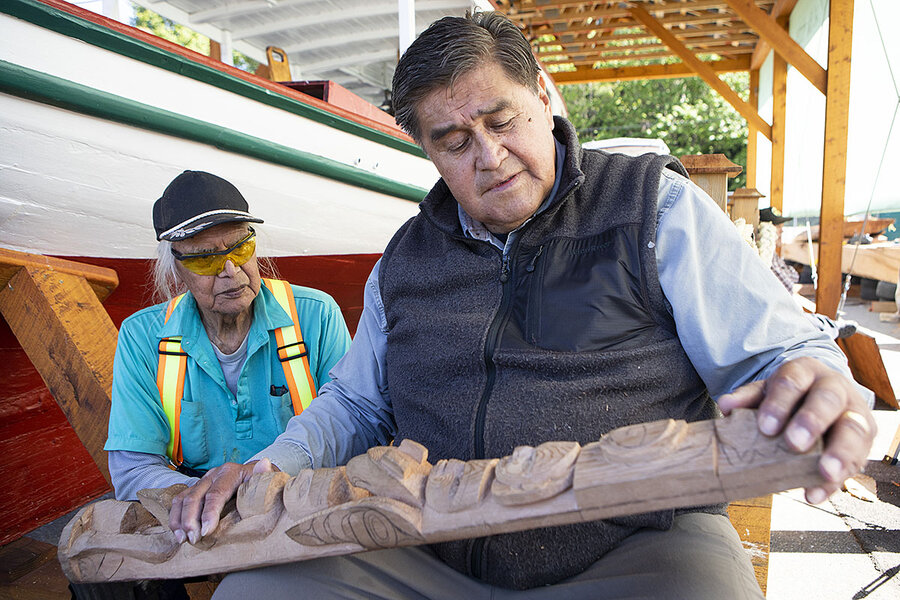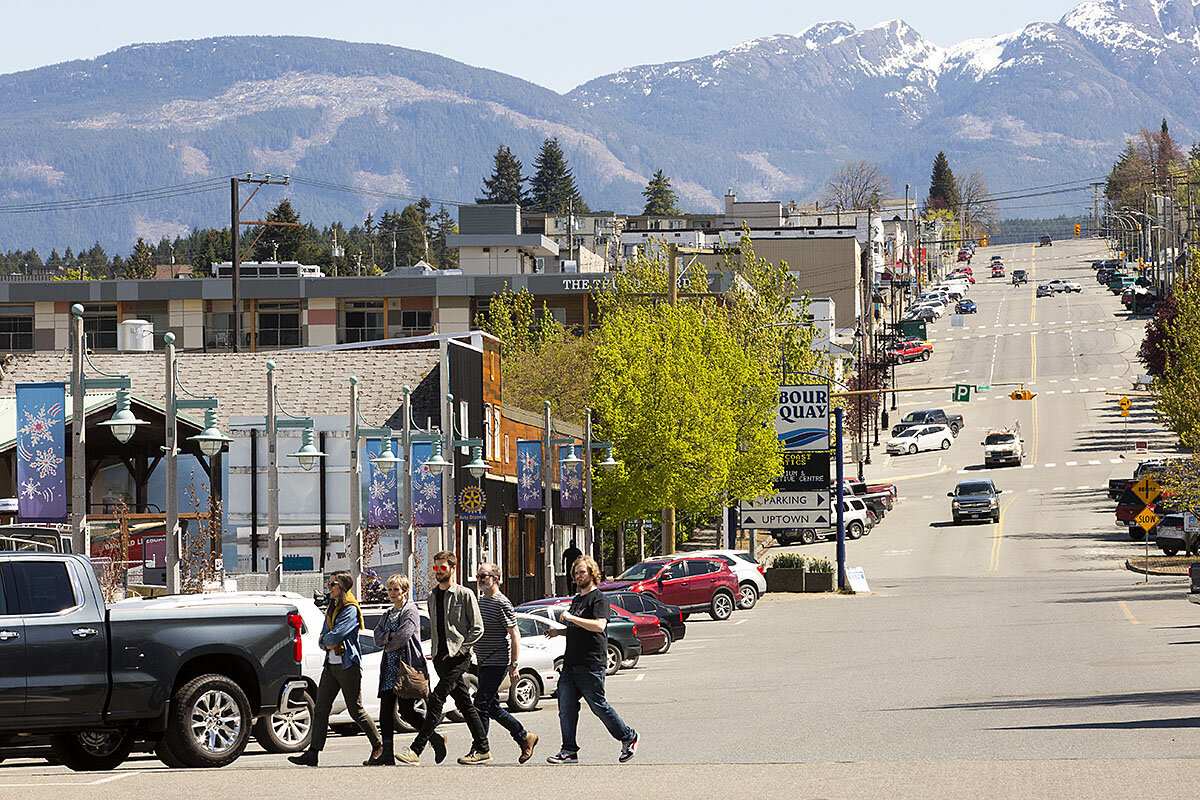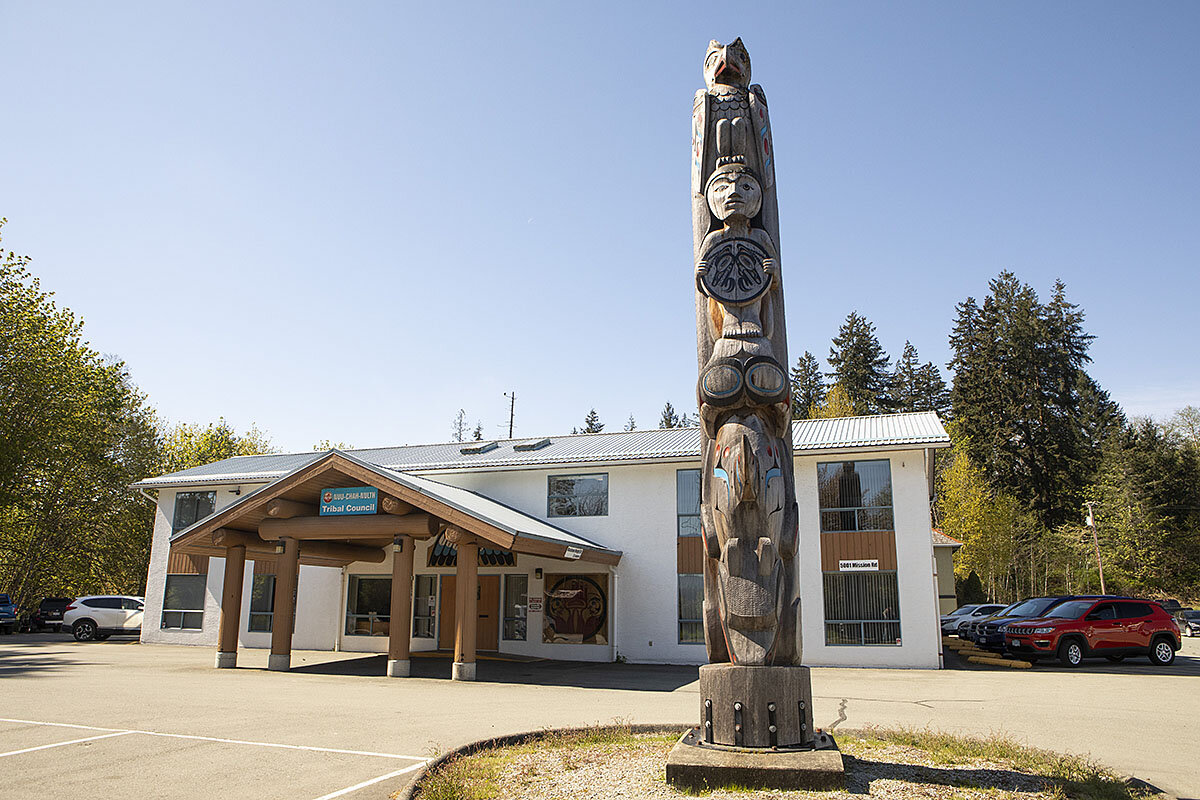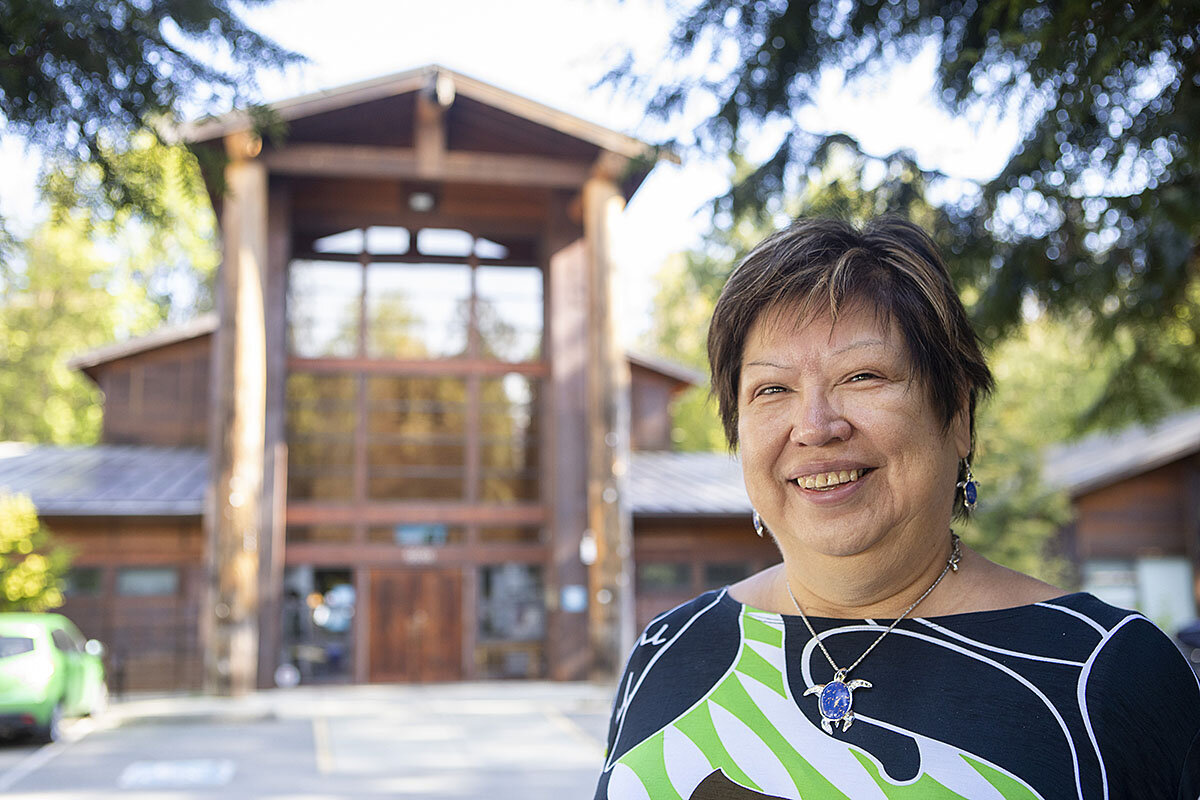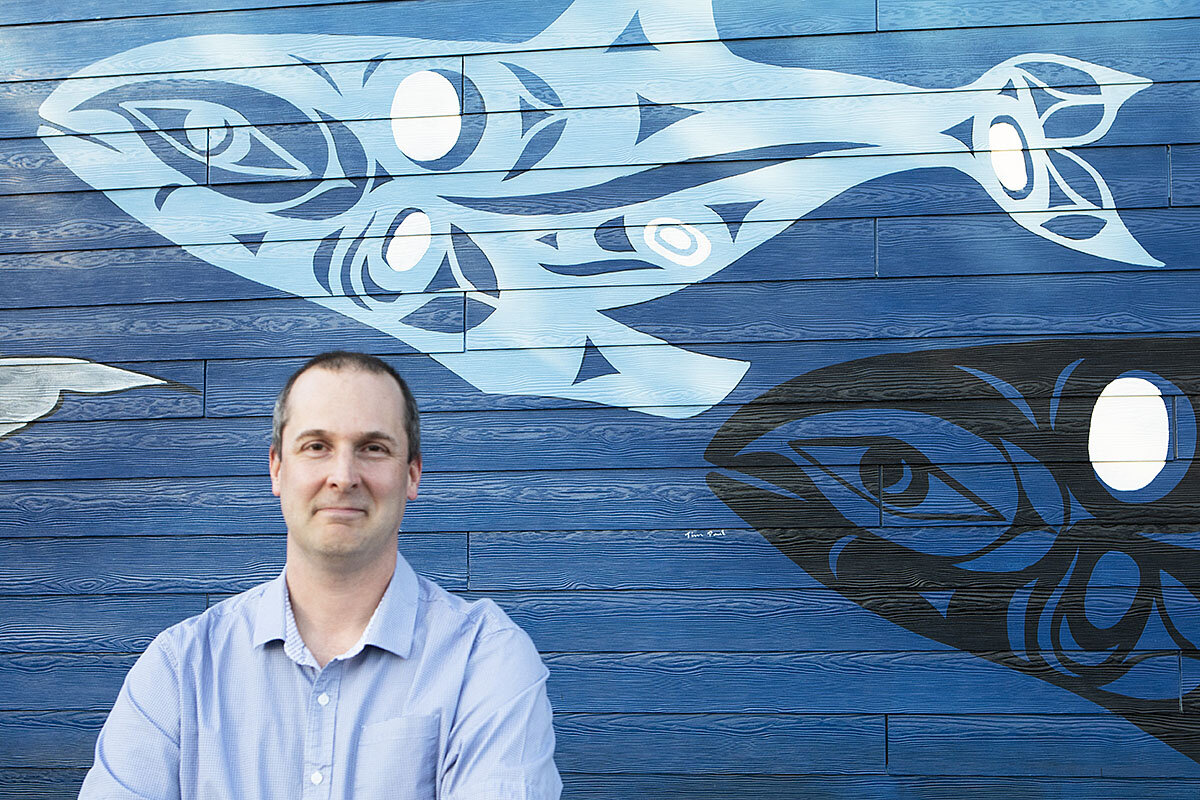Tired of waiting for Canada, native peoples reclaim their culture
Loading...
| Port Alberni, British Columbia
When carver Tim Paul searched for a cedar tree to build a totem pole honoring the preservation of Canada’s indigenous languages, he and his team chose a 75-foot windfall in the forests of Vancouver Island that was rotted throughout.
On a recent day along the harbor of Port Alberni, the group mills the 800-year-old trunk before it can stand strong and sustainably – a metaphor for the state of indigenous culture. “We’re doing this to save what we have left,” says Mr. Paul, who sprinkles sentences with Nuu-chah-nulth words but does not speak his native language fluently, due to being forced into state-regulated boarding school at age 6.
Commissioned by the First Nations Education Foundation to celebrate the United Nations’ 2019 Year of Indigenous Languages, the pole will be erected at the University of Victoria this fall. It will mark a public space intended to generate conversation about how indigenous language was silenced by residential schooling, says Scott Jeary, executive director of the First Nations Education Foundation in British Columbia. “It’s a recognition of what [Canada’s] real history is.”
Why We Wrote This
While Canada’s indigenous peoples agree the country has a long way to go in addressing a legacy of colonial abuse, they are making strides in restoring a cultural identity that was long repressed.
Mr. Paul, whose work has been shown around the world, is decorating the pole with what he describes as the relatives of his people: the sky, sun, moon, mountains, rivers, lakes, land, sea, wind, and stars. He will also depict an earthquake to teach human humility, he explains.
This is one of countless efforts and initiatives underway – and one of a flurry in Port Alberni alone – intended to advance “reconciliation” in Canada: the coming to terms with Canada’s legacy of colonial abuse.
Indigenous rights have remained at the top of the political and cultural agenda since Prime Minister Justin Trudeau took office, the same year the Truth and Reconciliation Commission released findings on abuses rife in the residential schooling system and their intergenerational consequences.
Mr. Trudeau is not the first Canadian leader to promise a reset on Canada’s relationship with indigenous peoples, but he raised expectations for the three different indigenous groups in Canada: First Nations, Metis, and Inuit. “No relationship is more important to Canada than the relationship with indigenous people,” Mr. Trudeau said in 2017.
Yet as his term comes to a close, many indigenous communities wonder if heady rhetoric has amounted to much more than a buzzword. Two-thirds of indigenous peoples don’t feel respected by the Canadian government, according to a poll commissioned by the CBC and published early this month. For Mr. Paul, the most important advances have come from indigenous reclamation of culture, not anything the government has promised or delivered.
Casting a long shadow over the principle of reconciliation – especially here in British Columbia – was the ouster of Jody Wilson-Raybould. She rose to power in this province and, under Mr. Trudeau, became the first justice minister of indigenous ancestry but was kicked out from his Liberal Party this spring. If her appointment stood as a symbol of what reconciliation should look like, her downfall has caused a rethink about what reconciliation has really accomplished beyond symbolism.
“It’s been lots of meetings, lots of photo-ops, lots of indigenous motifs, lots of process,” says Hayden King, director of the Yellowhead Institute, an indigenous-led think tank that opened a year ago at Ryerson University in Toronto. “And now even that is starting to fall apart.”
A dark history for indigenous peoples
The relationship between indigenous peoples in Canada – who number 1.6 million, according to the 2016 census – and colonial settlers has evolved, often violently, over hundreds of years. After the victory of Britain over France, the 1763 Royal Proclamation gave structure to British rule in North America – and formal recognition to aboriginal rights to land and resources. But those have been repeatedly disregarded when an obstacle to economic growth arose.
Since the formation of Canada in 1867, the federal government has been running indigenous affairs. In 1876, the Indian Act came into effect, essentially controlling the lives of First Nations people in Canada by regulating which indigenous people have “status” and which do not, a distinction that establishes their rights and benefits. Assimilation was the law’s primary goal.
By far the most notorious policy – and damaging to this day – was the residential schooling system that aimed to integrate indigenous children into Canadian society. An estimated 150,000 children were sent to boarding school, suffering physical and emotional violence that the larger public didn’t grasp until decades later.
The Truth and Reconciliation Commission of Canada has sought to address Canada’s dark history, releasing 94 calls to action in 2015 that have led to a flurry of government policy. In May, the Liberal government proposed changes to the citizenship oath to specifically recognize indigenous rights; in June, findings from the National Inquiry Into Murdered and Missing Indigenous Women and Girls in Canada was released.
Indigenous issues receive far more attention here than in the United States, even though the communities face similar repercussions of colonial violence. Reconciliation efforts are covered widely in the media. They are talked about in schools, at community functions, and at water coolers. The government keeps them at the top of the agenda.
“Reconciliation is imperative for Canada – for its progress as a country and as an example to the world,” said Canada’s minister of Crown-Indigenous Relations, Carolyn Bennett, as a guest at a Canadian Club of Toronto luncheon this spring.
When asked what keeps her up at night, she said she worried about the progress rolling backward. “We have momentum now,” she said.
‘A lot of baggage to the word’
But such words can ring hollow in places like Port Alberni, an old logging and mill town, ringed by snowcapped mountains in the traditional territories of the Hupacasath and Tseshaht First Nations – and never more so to local leadership as the scandal against Ms. Wilson-Raybould came to a head this year. Ms. Wilson-Raybould came under pressure from the prime minister’s office to help a Quebec engineering firm avoid prosecution on corruption charges and refused. That clash is widely believed to be the reason she was reshuffled this winter to the Veterans Affairs Ministry, and finally ejected from the Liberal Party altogether.
When Ms. Wilson-Raybould was named by Mr. Trudeau as attorney general and justice minister in 2015, it was a signal for many indigenous communities here that the government was truly ready to reconcile. Not all First Nations communities agreed with her decision to join the cabinet in the first place – essentially seeing it as her participation in the colonial system – but they felt hopeful about shifting power dynamics nonetheless.
Judith Sayers, who lives in Port Alberni and is president of the Nuu-chah-nulth Tribal Council on Vancouver Island, has worked with Ms. Wilson-Raybould throughout her political career, like most indigenous leaders in this province.
“It’s just that public humiliation. We all felt that,” she says. “And so you start looking at what it is that they’re doing with reconciliation, and there is no reflection on what First Nations want and need.”
On a recent day, on one of the main reservations of the Hupacasath First Nation where Dr. Sayers was a former chief, she says their real battle is reclaiming their land base – today they own 232 hectares (0.9 sq. miles), or 0.001% of the original mass. That’s bigger than many reserves, and theirs is better off. Some reservations still don’t have clean drinking water. Many homes are overcrowded. Poverty rates for indigenous people in Canada stand at 25%.
That’s part of the reason why when preparing for a series of meetings about indigenous priorities moving forward, Dr. Sayers wasn’t sure she wanted to use the term “reconciliation.” “There’s a lot of baggage to the word,” she says, “because everybody uses it and nobody really knows what it means. And if what the governments are doing is reconciliation, then maybe we don’t want it.”
Mr. King of the Yellowhead Institute says that indigenous people have worked hard to expose the myths of Canada. “I think people in the U.S., in Western Europe, really around world, think of Canada as this multicultural utopia. And for indigenous people, that’s not the case,” he says.
Reconciliation in the community
And yet, reconciliation is still playing out at the local level, perhaps more than ever. One of the most notorious residential schools sat just a few miles from the harbor of Port Alberni. But resident Chris Alemany didn’t know it. In fact, he didn’t even learn about the system until after he graduated from high school.
He was serving as an elected city councilor when reconciliation took off at the national level, and he started thinking about what it means in his hometown. In particular he thought about a street named after former lawmaker Alan Webster Neill, who both oversaw residential schools on behalf of the government (in a stint as an “Indian agent”) and was vehemently opposed to Japanese immigration to Canada.
Mr. Alemany presented a motion to have it renamed. The issue of historical memory got heated as it always does. One citizen, in a council meeting at the time, said he’d been called a white supremacist because he believes renaming isn’t worth the cost. He added that reconciliation, in some cases, does more harm than good. “I don’t feel that I was personally responsible and have to reconcile for things that I have nothing to do with,” he said at a recorded meeting.
For Mr. Alemany, changing street signs may seem trivial to some, but he saw it as urgent. “I think climate change and reconciliation are the two most important issues facing Canada if not most of the Western world,” he says, “because it’s the same kind of encroachment of Western civilization.”
The council voted against renaming Neill Street. But it generated a lot of soul-searching. Hundreds of indigenous and nonindigenous members supported a Walk for Reconciliation in 2017, which culminated in the city forming its own committee on reconciliation.
Their work has opened space for education, one of the key aims of national reconciliation, says Wally Samuel, a First Nations committee member. He says the relationship between indigenous and nonindigenous people in Port Alberni has improved markedly since he was sent to residential school here, but stereotypes and misunderstanding about what indigenous people have endured still exists.
“There are still a lot of poor First Nations with addictions. They are the ones you see on the street, and those are the ones people pick on,” he says. “A lot of them have been through something.”
Seeing oneself
For many First Nations residents here, moving forward is about reclamation of culture. At the Haahuupayak School, an indigenous-run primary school, students finish a drumming and dancing class before they scurry out to recess. Their teacher, Lena Ross, explains the value in their daily Nuu-chah-nulth lessons. “I think it gives us a firm foundation of who we are. It instills pride, a pride that nobody can dismantle.”
Ms. Ross says she grew up feeling empty, in the midst of a spiritual crisis of silence that she couldn’t grasp, until she met two older women who guided her. “I couldn’t see myself reflected anywhere,” she says. “They put everything back into me until I felt whole again as a person. And that’s why I’m here today, because I want everybody to feel the wholeness.”
For Ms. Ross, this is the work of reconciliation, which cannot be undone by any government action, policy, or election. She does not see the political fate of Ms. Wilson-Raybould as a setback but as progress – a First Nations woman in the government who stood up for what she thought was right. “I think Jody was a good example,” she says. “I look at her as a very strong First Nations woman who embraced the teachings and is not ready to tolerate the mistreatment of First Nations people.”
“I think she’s regained that spirit that was lost through residential school.”




